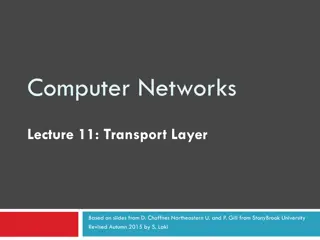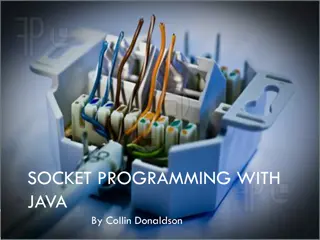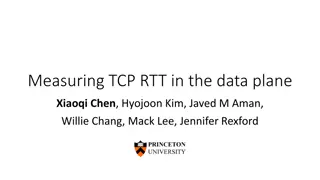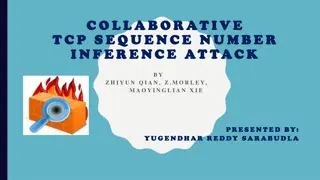Understanding TCP/IP Protocol Suite
TCP/IP, a fundamental protocol suite, defines rules and conventions essential for data communication. It consists of layers like Network Access, Internet, and Host-to-Host, each serving specific functions. The suite ensures proper syntax, semantics, and timing for effective data exchange between sender and receiver. Comparing TCP/IP with the OSI model reveals its unique layer structure. Explore the significance of each layer in facilitating reliable communication.
Download Presentation

Please find below an Image/Link to download the presentation.
The content on the website is provided AS IS for your information and personal use only. It may not be sold, licensed, or shared on other websites without obtaining consent from the author. Download presentation by click this link. If you encounter any issues during the download, it is possible that the publisher has removed the file from their server.
E N D
Presentation Transcript
TCP/IP Model What is a Protocol? Protocol is set of rules and conventions. Sender and receiver in data communication must agree on common set of rules before they can communicate with each other. Protocol defines. a) Syntax (what is to be communicated) b) Semantics (how is it to be communicated c) Timing (When it should be communicated)
TCP/IP Model TCP/IP Model The TCPIIP protocol suite was developed prior to the OSI model. Therefore, the layers in the TCP/IP protocol suite do not exactly match those in the OSI model. The original TCP/IP protocol suite was defined as having four layers: host-to-network, internet, transport, and application.
TCP/IP Model TCP/ IP Model
TCP/IP Model TCP/IP Model When TCP/IP is compared to OSI, The host-to-network layer is equivalent to the combination of the physical and data link layers. The internet layer is equivalent to the network layer, and the application layer doing the job of the session, presentation, and application layers.
TCP/IP Model TCP/IP Transmission control Protocol/Internet Protocol Developed by DARPA No official protocol standard Can identify five layers Application Host-to-Host (transport) Internet Network Access Physical
TCP/IP Model TCP/IP Network Access Layer Also called as Host-to-Network Layer. Performs all functions of physical Layer and Data Link Layer. Exchange of data between end system and network. Address of host and destination Prioritization of transmission. This deals with hardware level, connections as in other network model.
TCP/IP Model TCP/IP Network Access Layer TCP/IP Protocol Suite includes Host-to-Network Layer protocols such as- Serial Line Internet Protocol (SLIP) And Point to Point Protocol(PPP).
TCP/IP Model TCP/IP Internet Layer An Internet is an interconnection of two or more networks. Internet layer handles tasks similar to network access layer, but between networks rather than between nodes on a network. Uses IP for addressing and routing across networks. Implemented in workstations and routers.
TCP/IP Model TCP/IP Internet Layer This layer is concerned with the format of datagrams as defined in the internet protocol(IP). The protocols in this layer include Address Resolution Protocol (ARP), Reverse Address Resolution Protocol (RARP) and Internet Control Message Protocol (ICMP).
TCP/IP Model TCP/IP Transport Layer This layer is concerned with the transmission of the data. The two main protocols that operate at this layer are Transmission Control Protocol (TCP) and User Datagram Protocol (UDP). TCP is reliable transmission protocol and it guarantees that the proper data transfer will take place. UDP is not designed to be reliable or guarantee data delivery. Also called host-to-host layer
Functions of Transport Layer 1. Service point addressing: - Delivery is from specific process on computer to specific process on another computer. For this transport layer uses port addresses. 2. Segmentation and reassemble: -Each segment of a message contains a sequence number which is used to reassemble the message correctly. 3. Connection control:-Logical connection is created between source and destination for the duration of complete message transfer. 4. Flow control:-Flow control is performed end to end. 5. Error control:-Error control is performed process to process. It ensures that entire message arrives at receivers transport layer without error (damage or loss or duplication). Error correction is done by retransmission.
TCP/IP Model TCP/IP Application Layer The application layer is concerned with providing network services to applications. There are many application network processes and protocols that work at this layer, including Hyper Text Transfer Protocol (HTTP), Simple Mail Transport Protocol (SMTP) and File Transfer Protocol (FTP).
TCP/IP Model *TCP/IP Application Presentation Session TELNET FTP SMTP DNS SNMP DHCP RIP Transport RTP RTCP Transmission Control Protocol User Datagram Protocol OSPF ICMP IGMP Internet Protocol Network ARP Data link Physical Ethernet Token Bus Token Ring FDDI
TCP/IP Model Host-to-Network Layer Protocol Host to network Layer Defines two protocols SLIP PPP SLIP and PPP Protocols allow a user to dial into an ISP over Telephone Line.
TCP/IP Model SLIP SLIP-Serial Line Internet Protocol. It designed to work over serial ports and modem connections. Defines a sequence of bytes that frame IP packets on a serial line. Commonly used for point-to-point serial connections running TCP/IP. It is designed to transmit signals over a serial connection and has very low overhead.
TCP/IP Model PPP PPP means point to point protocol. It is a much more developed protocol than SLIP(which is why it is replacing it). It transfers additional data, better suited to data transmission over the Internet. PPP is More Complex than SLIP.
TCP/IP Model SLIP Vs PPP Serial Line Internet Protocol does not establish or maintain connection between the client and ISP server. In PPP, LCP (Line Control Protocol) is responsible for establishing, maintaining and termination connection between two end points. Communication starts once the connection between two modems are established. Communication begins only after authentication and the types of traffic is sent by the client. Type of traffic cannot be selected in SLIP. Type of traffic can be selected by NCP No protocol for termination. IPCP(IP Control Protocol) terminates a network layer connection between the user and ISP. No addressing mechanism provided. Additional services for addressing mechanism is provided Doesn t allow error control Allows error control No provision for data compression Provides Data compression.
TCP/IP Model Internet Layer Protocols The Five Network Layer protocols are: ARP RARP IP ICMP
TCP/IP Model ARP-Address Resolution Protocol ARP takes the IP address of a host as input & gives its corresponding physical address as the output. The Internet is based on IP addresses Data link protocols (Ethernet, FDDI, ATM) may have different (MAC) addresses The ARP and RARP protocols perform the translation between IP addresses and MAC layer addresses.
TCP/IP Model ARP And RARP Ethernet MAC address (48 bit) ARP IP address (32 bit) RARP
TCP/IP Model ARP Protocol ARP sends the IP broadcast message to all the computer on the network. The computer whose IP address matches the broadcast IP address sends a reply and along with its physical address to the broadcasting computer. All other computers ignore the broadcast message
TCP/IP Model Address Translation with ARP ARP request: Argon broadcasts an ARP request to all stations on the network: What is the hardware address of Router137? Argon Router137 128.143.137.1 00:e0:f9:23:a8:20 128.143.137.144 00:a0:24:71:e4:44 ARP Request: What is the MAC address of 128.143.71.1?
TCP/IP Model Address Translation with ARP ARP Reply: Router137 responds with an ARP Reply which contains the hardware address Argon Router137 128.143.137.1 00:e0:f9:23:a8:20 128.143.137.144 00:a0:24:71:e4:44 ARP Reply: The MAC address of 128.143.71.1 is 00:e0:f9:23:a8:20
TCP/IP Model RARP Reverse Address Resolution Protocol. If we have to obtain the IP address corresponding to the given Ethernet address. RARP works in very similar way of ARP, but in exactly opposite direction. The RARP server looks at this request. Then it looks up the Ethernet address in its configuration files and sends back the corresponding IP address.
TCP/IP Model Internet Protocol (IP) It Is A Routable Protocol Responsible For IP Addressing, Routing, and The Fragmentation and Reassembly Of Packets. It Has The Task Of Delivering Packets From The Source Host To The Destination Host Solely Based On The IP Address In The Packet Headers. For This Purpose, IP Defines Packet Structures That Encapsulate The Data To Be Delivered. It Also Defines Addressing Methods That Are Used To Label The Datagram With Source And Destination Information.
TCP/IP Model Internet Protocol (IP) IP is internet Protocol. It is unreliable protocol because it does not provide any error control and flow control. Packets in IP are called Datagram . Datagram is variable length packet with two parts header and data
The IPv4 header is comprised of 12 required fields and 1 optional field. The minimum length of the header is 160 bits (20 bytes).
IPV6 IP version 6 (IPv6) is an advanced version of IPv4. It takes all good features of IPv4 and adds new ones. Larger address space: IPv6 uses 128 bit(16 Bytes) Address. Better header format: This simplifies and speeds up the routing process. New options. IPv6 has new options to allow for additional functionalities. Allowance for extension : IPv6 is designed to allow the extension of the protocol if required by new technologies or applications.
IPv6major goals : 1. Support billions of hosts. 2. Reduce the size of the routing tables. 3. Simplify the protocol. 4. Provide better security (authentication and privacy). 5. More attention to the type of service 6. Aid multicasting by allowing scopes to be specified. 7. Make it possible for a host to roam without changing its address. 8. Allow the protocol to evolve in the future. 9. Permit the old and new protocols to coexist for years.
IPv6 Header Format Priority
IPv4 1. Source and destination addresses are 32 bits (4 bytes) in length. 2. Uses broadcast addresses to send traffic to all nodes on a subnet. IPv6 1. Source and destination addresses are 128 bits(16 bytes) in length. 2. There are no IPv6 broadcast addresses. Instead, multicast scoped addresses are used. 3. Fragmentation is supported at Originating hosts and intermediate routers. 3. Fragmentation is not supported at routers. 4.IP header include a checksum. 5.IP header includes options. 4.IP header does not include a checksum. 5. All optional data is moved to IPv6 extension headers.
6.IPsec support is optional 6.IPsec support is required in a full IPv6 implementation. 7. Payload identification for QoS handling By routers is included in theIPv6 header using the Flow Label field. 8. IP address is represented in hexadecimal number system 7. No identification of payload for QoS Handling by routers is present within the IPv4 header. 8. IP address represented in decimal number system 9. . used as separator 9. : used as separator .
Transport Layer Protocols Transport Layer Works on top of Internet Layer. It is concerned with transport of packets from the source to destination. In TCP/IP the transport layer is represented by two Protocols: TCP UDP
Transmission Control Protocol TCP is transmission control protocol. It Provides: Connection oriented service Reliable service Stream delivery service Sending and receiving buffers Bytes and segments Full duplex service Process to process communication
TCP TCP is a connection oriented protocol. Connection oriented means that a virtual connection is established before any user data is transferred. If the connection cannot be established, the user program is notified. If the connection is ever interrupted, the user program finds out there is a problem.
TCP TCP is Reliable- Reliable means that every transmission of data is acknowledged by the receiver. Reliable does not mean that things don't go wrong, it means that we find out when things go wrong. If the sender does not receive acknowledgement within a specified amount of time, the sender retransmits the data.
TCP Stream delivery service: TCP is a stream oriented protocol. It allows the sending and receiving process to obtain as a stream of bytes. TCP creates a working environment in such a way that the sending and receiving processes seem to be connected by an imaginary tube This is called as stream delivery service.
TCP : Flow Control Sending and receiving buffers: The sending and receiving process may not produce and receive data at the same speed. Hence TCP needs buffers for storage. There are two types of buffers used in each direction: 1) Sending buffer 2) Receiving buffer
TCP Full duplex service: TCP offers full duplex service where the data can flow in both the direction simultaneously. The TCP segments are sent both the directions. Process to process communication: The TCP uses port numbers as transport layer addresses. Also called as Port to Port communication.
TCP Header 1 byte 1 byte 1 byte 1 byte Source Port Destination Port Sequence Number Acknowledgment Number Control Checksum offset Reser. Window size Urgent Pointer Options (if any) Data
UDP UDP is user datagram protocol. It is connectionless protocol because data is sent without establishing a connection between sender and receiver before sending the data. UDP is unreliable because data is delivered without acknowledgement. UDP does not perform Auto retransmission. UDP does not use flow control . UDP has high transmission speed.
UDP UDP Datagram Format Source Port Destination Port Length Checksum Data
TCP 1. TCP is connection oriented protocol 2. It provides reliable delivery of messages 2. It provides unreliable delivery of UDP 1. UDP is connection less protocol messages 3. Every datagram segment is of the same size. 4. UDP has no flow control 5. Overhead is very low. 6. Transmission speed is very high 3. It assigns datagram size dynamically for efficiency. 4. TCP has flow control 5. Overhead is low 6. Transmission speed is high
UDP TCP Complexity UDP is less complex TCP is more complex Connection UDP is connection less protocol TCP is connection oriented protocol Reliability It provides unreliable delivery of messages It provides reliable delivery of messages Function By using this protocol one program can send a load of packets to another and that would be the end of the relationship. As a message makes its way across the internet from one computer to another. This is connection based. Which layer they exist Flow controlling UDP has no flow control Transport layer Transport layer TCP has flow control Overhead Overhead is very low Overhead is low Which is powerful UDP is less powerful TCP is more powerful.
Application Layer Protocols DHCP SMTP FTP DNS Telnet
DHCP DHCP (Dynamic Host Configuration Protocol) is a client- server protocol that uses DHCP servers and DHCP clients. A DHCP server is a machine that runs a service that can lease out IP addresses and other TCP/IP information to any client that requests them. The DHCP server typically has a pool of IP addresses that it is allowed to distribute to clients, and these clients lease an IP address from the pool for a specific period of time, usually several days. Once the lease is ready to expire, the client contacts the server to arrange for renewal. DHCP clients are client machines that run special DHCP client software enabling them to communicate with DHCP server.
DHCP DHCP clients obtain a DHCP lease for an IP address, a subnet mask, and various DHCP options from DHCP servers in a four-step process: DHCP DISCOVER: The client broadcasts a request for a DHCP server. DHCPOFFER: DHCP servers on the network offer an address to the client. DHCPREQUEST: The client broadcasts a request to lease an address from one of the offering DHCP servers. DHCPACK: The DHCP server that the client responds to acknowledges the client, assigns it any configured DHCP options, and updates its DHCP database. The client then initializes and binds its TCP/IP protocol stack and can begin network communication.
SMTP SMTP is simple mail transfer protocol. It is connection oriented text based protocol. Sender communicates with receiver using a command and supplying data over reliable TCP connection. SMTP is standard application layer protocol for delivery of email over TCP/IP network. SMTP establish a TCP connection between Sender And port number 25 of receiver.























